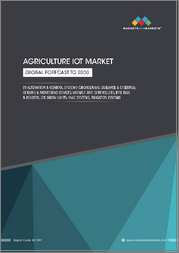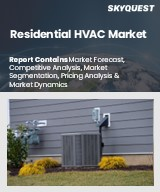
|
시장보고서
상품코드
1678013
세계의 냉난방공조(HVAC) 시스템 시장 규모, 점유율, 성장 분석 : 기기별, 최종 용도별, 지역별 - 산업 예측(2025-2032년)Heating Ventilation and Cooling (HVAC) System Market Size, Share, and Growth Analysis, By Equipment (Heat Pumps, Air Conditioning), By End-use (Residential, Commercial), By Region - Industry Forecast 2025-2032 |
||||||
냉난방공조(HVAC) 시스템 시장 규모는 2023년 320억 달러로 평가되었고, 예측 기간(2025-2032년) 동안 6.8%의 연평균 복합 성장률(CAGR)로 2024년 341억 8,000만 달러에서 2032년에는 578억 5,000만 달러로 성장할 것으로 예상됩니다.
2023년 10월 현재, 교육기관의 냉난방공조(HVAC) 시스템 시장은 에너지 효율에 대한 요구와 실내 공기질에 대한 우려로 인해 크게 성장하고 있습니다. 이러한 시스템은 최적의 열적 쾌적성과 적절한 환기를 유지하는 데 매우 중요하며, 학교의 주요 에너지 소비원으로서 HVAC 장비 선택 과정에서 에너지 효율성, 습도 조절, 자연 환기 가능성 등 다양한 요소를 신중하게 고려해야 합니다. 특히 하이브리드 난방 시스템은 자동 온도 조절에 대한 수요 증가에 힘입어 많은 사랑을 받고 있습니다. 또한, 상업 및 주거 부문의 견조한 건설 활동과 식음료 및 통신 산업 수요 증가도 시장 확대에 기여하고 있습니다. 그러나 숙련된 전문가의 부족은 이러한 성장에 잠재적인 장벽으로 작용하고 있습니다.
목차
서론
- 조사 목적
- 조사 범위
- 정의
조사 방법
- 정보 조달
- 2차와 1차 데이터 방법
- 시장 규모 예측
- 시장 전제조건과 제한
주요 요약
- 세계 시장 전망
- 공급과 수요 동향 분석
- 부문별 기회 분석
시장 역학과 전망
- 시장 개요
- 시장 규모
- 시장 역학
- 성장 촉진요인과 기회
- 성장 억제요인과 과제
- Porter의 Five Forces 분석
주요 시장 인사이트
- 중요 성공 요인
- 경쟁 정도
- 주요 투자 기회
- 시장 생태계
- 시장의 매력 지수(2024년)
- PESTEL 분석
- 거시경제 지표
- 밸류체인 분석
- 가격 분석
- 사례 연구
- 규제 상황
- 특허 분석
냉난방공조(HVAC) 시스템 시장 규모 : 기기별&CAGR(2025-2032년)
- 시장 개요
- 히트펌프
- 공조
- 공기청정기
- 칠러
- 보일러
냉난방공조(HVAC) 시스템 시장 규모 : 최종 용도별&CAGR(2025-2032년)
- 시장 개요
- 주택용
- 상업용
- 산업용
냉난방공조(HVAC) 시스템 시장 규모 : 지역별&CAGR(2025-2032년)
- 북미
- 미국
- 캐나다
- 유럽
- 독일
- 스페인
- 프랑스
- 영국
- 이탈리아
- 기타 유럽
- 아시아태평양
- 중국
- 인도
- 일본
- 한국
- 기타 아시아태평양
- 라틴아메리카
- 브라질
- 기타 라틴아메리카
- 중동 및 아프리카
- GCC 국가
- 남아프리카공화국
- 기타 중동 및 아프리카
경쟁 정보
- 주요 5개사 비교
- 주요 기업의 시장 포지셔닝(2024년)
- 주요 시장 기업이 채택한 전략
- 최근 시장 동향
- 기업의 시장 점유율 분석(2024년)
- 주요 기업 개요
- 기업 상세
- 제품 포트폴리오 분석
- 기업 부문별 점유율 분석
- 매출 전년대비 비교(2022-2024년)
주요 기업 개요
- Carrier Corporation(USA)
- Daikin Industries, Ltd.(Japan)
- Johnson Controls International plc(Ireland)
- Trane Technologies plc(Ireland)
- LG Electronics Inc.(South Korea)
- Samsung Electronics Co., Ltd.(South Korea)
- Lennox International Inc.(USA)
- Honeywell International Inc.(USA)
- Toshiba Corporation(Japan)
- Panasonic Corporation(Japan)
- Hitachi, Ltd.(Japan)
- Fujitsu General Limited(Japan)
- Gree Electric Appliances Inc.(China)
- Midea Group Co., Ltd.(China)
- Haier Group Corporation(China)
- Ingersoll Rand Inc.(USA)
- Bosch Thermotechnology(Germany)
- Danfoss A/S(Denmark)
- Emerson Electric Co.(USA)
결론과 제안
LSH 25.04.21Heating Ventilation and Cooling (HVAC) System Market size was valued at USD 32.0 billion in 2023 and is poised to grow from USD 34.18 billion in 2024 to USD 57.85 billion by 2032, growing at a CAGR of 6.8% during the forecast period (2025-2032).
As of October 2023, the market for heating, ventilation, and cooling (HVAC) systems in educational institutions is experiencing significant growth due to rising energy efficiency demands and indoor air quality concerns. These systems are crucial for maintaining optimal thermal comfort and adequate ventilation, making them major energy consumers in schools. The selection process for HVAC equipment requires careful consideration of various factors, including energy efficiency, humidity control, and potential for natural ventilation. Hybrid heating systems are particularly gaining traction, driven by an increasing need for automatic temperature adjustments. Additionally, robust construction activity in commercial and residential sectors, alongside growing demands from the food and beverage and telecom industries, fuels market expansion. However, a shortage of skilled professionals poses a potential barrier to this growth.
Top-down and bottom-up approaches were used to estimate and validate the size of the Heating Ventilation And Cooling (Hvac) System market and to estimate the size of various other dependent submarkets. The research methodology used to estimate the market size includes the following details: The key players in the market were identified through secondary research, and their market shares in the respective regions were determined through primary and secondary research. This entire procedure includes the study of the annual and financial reports of the top market players and extensive interviews for key insights from industry leaders such as CEOs, VPs, directors, and marketing executives. All percentage shares split, and breakdowns were determined using secondary sources and verified through Primary sources. All possible parameters that affect the markets covered in this research study have been accounted for, viewed in extensive detail, verified through primary research, and analyzed to get the final quantitative and qualitative data.
Heating Ventilation And Cooling (Hvac) System Market Segments Analysis
Global Heating Ventilation and Cooling (HVAC) System Market is segmented by Equipment, End-use and region. Based on Equipment, the market is segmented into Heat Pumps, Air Conditioning, Air Purifiers, Chillers and Boilers. Based on End-use, the market is segmented into Residential, Commercial and Industrial. Based on region, the market is segmented into North America, Europe, Asia Pacific, Latin America and Middle East & Africa.
Driver of the Heating Ventilation And Cooling (Hvac) System Market
The growing consumer awareness regarding the benefits of HVAC systems is significantly driving market demand. This increased understanding highlights advantages such as improved indoor air quality, enhanced comfort, and reduced energy costs. As more individuals recognize how HVAC systems can enhance their living environments and contribute to energy efficiency, the appeal of these systems continues to rise. Consequently, this influx of demand is pushing the HVAC market forward, as consumers become more informed and seek solutions that provide both comfort and economic benefits. This trend reflects a broader shift towards prioritizing better living conditions and sustainability in energy consumption.
Restraints in the Heating Ventilation And Cooling (Hvac) System Market
The HVAC system market faces significant restraints due to a shortage of skilled professionals. This deficiency could adversely affect market growth, especially as companies aim to introduce approximately 100,000 new HVAC systems in the coming years. If the workforce does not adequately meet the essential demand for qualified technicians, the potential for expansion in this sector may be severely hindered. The imbalance between supply and the increasing requirements for installation and maintenance might lead to challenges in achieving projected growth targets, ultimately resulting in a decline in market performance.
Market Trends of the Heating Ventilation And Cooling (Hvac) System Market
The HVAC system market is witnessing a significant trend towards smart technology integration, driven by consumer demand for enhanced convenience and efficiency. With advancements in IoT and automation, more HVAC systems now allow for remote operation through smartphones and computers, enabling homeowners to adjust their heating and cooling from anywhere. This connectivity not only optimizes energy consumption but also enhances system reliability, as users receive real-time alerts about potential issues, thus preventing costly repairs. As environmental concerns and energy efficiency continue to drive the market, the shift towards smarter, more connected HVAC solutions is expected to accelerate, shaping future innovations.
Table of Contents
Introduction
- Objectives of the Study
- Scope of the Report
- Definitions
Research Methodology
- Information Procurement
- Secondary & Primary Data Methods
- Market Size Estimation
- Market Assumptions & Limitations
Executive Summary
- Global Market Outlook
- Supply & Demand Trend Analysis
- Segmental Opportunity Analysis
Market Dynamics & Outlook
- Market Overview
- Market Size
- Market Dynamics
- Drivers & Opportunities
- Restraints & Challenges
- Porters Analysis
- Competitive rivalry
- Threat of substitute
- Bargaining power of buyers
- Threat of new entrants
- Bargaining power of suppliers
Key Market Insights
- Key Success Factors
- Degree of Competition
- Top Investment Pockets
- Market Ecosystem
- Market Attractiveness Index, 2024
- PESTEL Analysis
- Macro-Economic Indicators
- Value Chain Analysis
- Pricing Analysis
- Case Studies
- Regulatory Landscape
- Patent Analysis
Global Heating Ventilation and Cooling (HVAC) System Market Size by Equipment & CAGR (2025-2032)
- Market Overview
- Heat Pumps
- Air Conditioning
- Air Purifiers
- Chillers
- Boilers
Global Heating Ventilation and Cooling (HVAC) System Market Size by End-use & CAGR (2025-2032)
- Market Overview
- Residential
- Commercial
- Industrial
Global Heating Ventilation and Cooling (HVAC) System Market Size & CAGR (2025-2032)
- North America (Equipment, End-use)
- US
- Canada
- Europe (Equipment, End-use)
- Germany
- Spain
- France
- UK
- Italy
- Rest of Europe
- Asia Pacific (Equipment, End-use)
- China
- India
- Japan
- South Korea
- Rest of Asia-Pacific
- Latin America (Equipment, End-use)
- Brazil
- Rest of Latin America
- Middle East & Africa (Equipment, End-use)
- GCC Countries
- South Africa
- Rest of Middle East & Africa
Competitive Intelligence
- Top 5 Player Comparison
- Market Positioning of Key Players, 2024
- Strategies Adopted by Key Market Players
- Recent Developments in the Market
- Company Market Share Analysis, 2024
- Company Profiles of All Key Players
- Company Details
- Product Portfolio Analysis
- Company's Segmental Share Analysis
- Revenue Y-O-Y Comparison (2022-2024)
Key Company Profiles
- Carrier Corporation (USA)
- Company Overview
- Business Segment Overview
- Financial Updates
- Key Developments
- Daikin Industries, Ltd. (Japan)
- Company Overview
- Business Segment Overview
- Financial Updates
- Key Developments
- Johnson Controls International plc (Ireland)
- Company Overview
- Business Segment Overview
- Financial Updates
- Key Developments
- Trane Technologies plc (Ireland)
- Company Overview
- Business Segment Overview
- Financial Updates
- Key Developments
- LG Electronics Inc. (South Korea)
- Company Overview
- Business Segment Overview
- Financial Updates
- Key Developments
- Samsung Electronics Co., Ltd. (South Korea)
- Company Overview
- Business Segment Overview
- Financial Updates
- Key Developments
- Lennox International Inc. (USA)
- Company Overview
- Business Segment Overview
- Financial Updates
- Key Developments
- Honeywell International Inc. (USA)
- Company Overview
- Business Segment Overview
- Financial Updates
- Key Developments
- Toshiba Corporation (Japan)
- Company Overview
- Business Segment Overview
- Financial Updates
- Key Developments
- Panasonic Corporation (Japan)
- Company Overview
- Business Segment Overview
- Financial Updates
- Key Developments
- Hitachi, Ltd. (Japan)
- Company Overview
- Business Segment Overview
- Financial Updates
- Key Developments
- Fujitsu General Limited (Japan)
- Company Overview
- Business Segment Overview
- Financial Updates
- Key Developments
- Gree Electric Appliances Inc. (China)
- Company Overview
- Business Segment Overview
- Financial Updates
- Key Developments
- Midea Group Co., Ltd. (China)
- Company Overview
- Business Segment Overview
- Financial Updates
- Key Developments
- Haier Group Corporation (China)
- Company Overview
- Business Segment Overview
- Financial Updates
- Key Developments
- Ingersoll Rand Inc. (USA)
- Company Overview
- Business Segment Overview
- Financial Updates
- Key Developments
- Bosch Thermotechnology (Germany)
- Company Overview
- Business Segment Overview
- Financial Updates
- Key Developments
- Danfoss A/S (Denmark)
- Company Overview
- Business Segment Overview
- Financial Updates
- Key Developments
- Emerson Electric Co. (USA)
- Company Overview
- Business Segment Overview
- Financial Updates
- Key Developments



















